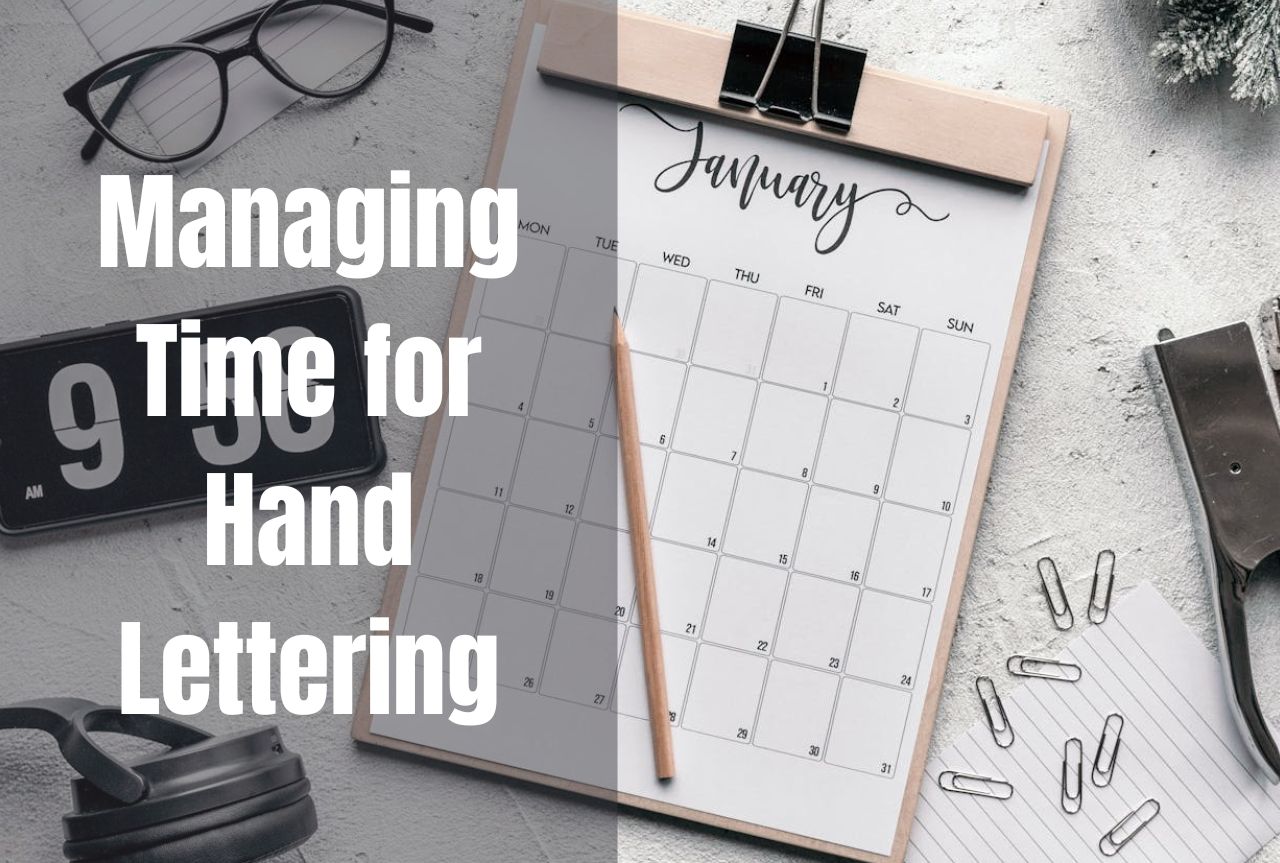Mastering the art of hand lettering requires not only creativity and skill but also effective time management. In a world filled with countless demands and distractions, finding the right balance between hand lettering and other commitments can be a challenge. This comprehensive guide will provide you with practical strategies and techniques to help you make the most of your time and achieve your hand-lettering goals.
Setting Clear Goals and Priorities
Identifying Your Hand Lettering Goals
Before diving into time management strategies, it’s essential to define your hand lettering goals. Ask yourself what you aim to accomplish with hand lettering – is it a hobby, a side hustle, or a full-time career? Once you’ve established your goals, determine the amount of time you can realistically dedicate to hand lettering each week or month.
Remember, hand lettering is a skill that requires consistent practice, so be realistic about your goals and the time commitment required. By aligning your goals with your available time, you’ll be better equipped to prioritize tasks and manage your schedule effectively.
Prioritizing Tasks and Projects
Not all hand-lettering tasks and projects are created equal. Some may be more urgent or important than others. To ensure you’re focusing your time and energy on the right things, it’s crucial to prioritize your tasks and projects.
One effective method is the Eisenhower Matrix, which categorizes tasks based on their importance and urgency. Tasks that are both important and urgent should be tackled first, followed by important but not urgent tasks, urgent but not important tasks, and finally, tasks that are neither important nor urgent.
Another approach is the ABCDE method, where you assign a letter to each task based on its priority. ‘A’ tasks are the most important and should be completed first, followed by ‘B’ tasks, and so on.
By prioritizing your tasks and projects, you’ll be able to allocate your time more effectively and ensure that you’re making progress toward your hand lettering goals.
Creating a Productive Environment
Organizing Your Workspace
A cluttered and disorganized workspace can be a significant source of distraction and hinder your productivity. To create an environment conducive to focused work, set up a dedicated workspace for hand lettering.
Ensure that your workspace is well-lit, comfortable, and free from clutter. Keep your supplies organized and within easy reach, so you don’t waste time searching for them. Consider investing in storage solutions like pegboards, trays, or organizers to keep your tools and materials neatly arranged.
Minimizing distractions in your workspace is also crucial. Remove or silence potential distractions like TVs, phones, or unnecessary electronics. If you find yourself easily distracted by external noise, consider using noise-canceling headphones or playing ambient music to help you stay focused.
Developing Routines and Habits
Establishing routines and habits can significantly improve your productivity and time management skills. When it comes to hand lettering, try to set aside a consistent time each day or week for practice and projects.
Incorporating hand lettering into your daily routine can help make it a habit and increase the likelihood of sticking to your schedule. For example, you could dedicate an hour before work or in the evening to hand lettering.
To reinforce these habits, consider using habit-tracking techniques such as apps, calendars, or physical trackers. Seeing your progress and streaks can provide motivation and accountability, making it easier to maintain your routine.
Time Management Strategies
The Pomodoro Technique
The Pomodoro Technique is a popular time management method that can be particularly useful for hand lettering. It involves working in focused intervals, typically 25 minutes, followed by short breaks.
During the 25-minute work intervals, you concentrate solely on your hand lettering task without distractions. When the timer goes off, you take a 5-minute break to recharge before starting another 25-minute work session.
This technique can help you stay focused and productive while preventing burnout or fatigue. It’s particularly effective for hand lettering tasks that require sustained concentration, such as practicing letterforms or working on detailed projects.
Batch Processing and Task Batching
Batch processing and task batching involve grouping similar tasks and completing them in a focused block of time. This approach can be highly effective for hand lettering, as it minimizes the time and mental effort required to switch between different types of tasks.
For example, you could dedicate a specific time block to practicing letterforms or working on a series of related hand lettering projects. By batching these tasks together, you’ll be able to maintain a consistent flow and avoid the disruption of switching between different types of tasks.
Additionally, task batching can help you leverage momentum and enter a state of “flow,” where you’re fully immersed and focused on the task at hand.
Time Blocking and Scheduling
Time blocking and scheduling involve allocating specific time slots in your calendar for different tasks and activities. This method can be particularly useful for hand lettering, as it allows you to dedicate focused time to your craft without interruptions.
Start by analyzing your weekly schedule and identifying available time blocks. Then, allocate these time blocks to specific hand lettering tasks or projects. Be sure to account for other commitments, such as work, family, or personal obligations, and adjust your schedule accordingly.
Once you’ve created your schedule, treat your hand-lettering time blocks as sacred appointments that cannot be rescheduled or interrupted. This approach can help you stay on track and ensure that hand lettering receives the dedicated time it deserves.
Overcoming Procrastination and Distractions
Identifying and Addressing Procrastination Triggers
Procrastination can be a significant obstacle to effective time management and productivity. To overcome procrastination, it’s essential to identify and address your triggers.
Common procrastination triggers include fear of failure, perfectionism, lack of motivation, or simply feeling overwhelmed by a task. Take some time to reflect on the situations or tasks that often lead you to procrastinate.
Once you’ve identified your triggers, develop strategies to address them. For example, if fear of failure is a trigger, remind yourself that practice and mistakes are essential for growth in hand lettering. If you struggle with perfectionism, set realistic goals and celebrate progress rather than focusing solely on the result.
Managing Distractions and Multitasking
In today’s digital age, distractions are ubiquitous, and it’s easy to fall into the trap of multitasking. However, multitasking can significantly reduce your productivity and focus, especially when it comes to creative pursuits like hand lettering.
To minimize distractions, start by identifying the sources of distraction in your environment. These could include notifications from your phone or computer, social media, or even background noise. Once you’ve identified the distractions, take steps to eliminate or minimize them during your hand lettering sessions.
Techniques like using website blockers, turning off notifications, or working in a quiet, distraction-free environment can help you stay focused and present during your hand lettering time.
Additionally, resist the temptation to multitask while working on hand lettering projects. Multitasking divides your attention and can lead to mistakes, decreased quality, and reduced productivity.
Utilizing Technology and Apps
Productivity Apps and Tools
While technology can be a source of distraction, it can also be a powerful ally in your time management efforts. There are numerous productivity apps and tools available that can help you stay organized, track your time, and streamline your hand lettering workflow.
Task management apps like Trello, Asana, or Todoist can help you organize and prioritize your hand-lettering projects and tasks. These apps often include features like due dates, reminders, and collaboration tools, making it easier to stay on top of your workload.
Time-tracking apps like Toggl or RescueTime can provide valuable insights into how you’re spending your time, allowing you to identify and address areas where you may be losing productivity.
Additionally, consider investing in digital tools specifically designed for hand lettering, such as lettering apps or digital pens and tablets. These tools can streamline your workflow, provide new creative possibilities, and potentially save you time in the long run.
Time Tracking and Analysis
Effective time management relies on understanding how you’re currently spending your time. Time tracking and analysis can provide valuable insights into your productivity patterns, helping you identify areas for improvement and make more informed decisions about your time allocation.
Start by tracking your time for a week or two, noting how much time you spend on different hand lettering tasks, as well as other activities and commitments. You can use a simple spreadsheet, a dedicated time-tracking app, or even a pen and paper to record your time.
Once you have this data, analyze it to identify patterns and areas for optimization. Look for time sinks or activities that are consuming more time than you anticipated. Also, identify periods of peak productivity and try to schedule your most important hand-lettering tasks during those times.
Regular time tracking and analysis can help you make data-driven decisions about your time management strategies, ensuring that you’re consistently making progress toward your hand lettering goals.
Conclusion
Effective time management is a crucial component of success in hand lettering. By setting clear goals, prioritizing tasks, creating a productive environment, implementing time management strategies, overcoming procrastination and distractions, and leveraging technology and apps, you can maximize your productivity and achieve your hand lettering aspirations.
Remember, time management is an ongoing process that requires consistent effort and adaptation. Regularly review and refine your strategies to ensure they align with your evolving goals and circumstances.
With dedication, discipline, and the right time management techniques, you can unlock your full potential as a hand letterer and create stunning works of art while maintaining a balanced and fulfilling life.



